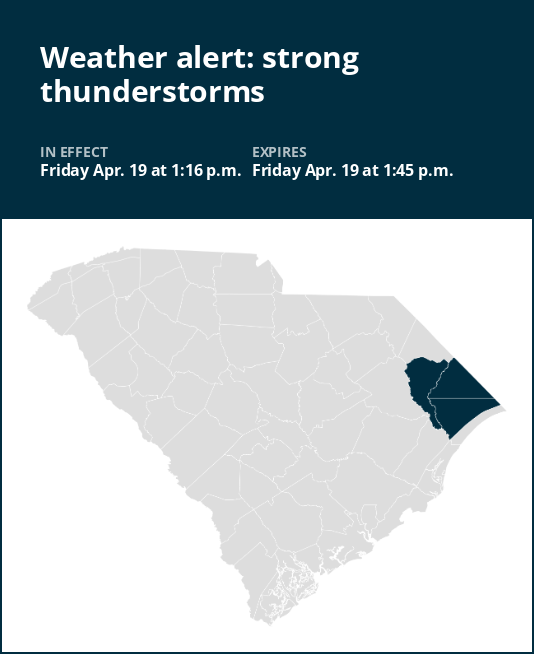An updated report was issued from the National Weather Service on Friday at 1:43 p.m. for strong thunderstorms until 2:30 p.m. for Dillon, Marion and Horry counties.
The storms may bring marble-sized hail (0.5 inches) and wind gusts of up to 40 mph.
“At 1:43 p.m., Doppler radar tracked strong thunderstorms along a line extending from near Mullins to near Horry. Movement was northeast at 25 mph,” says the weather service. “Gusty winds could knock down tree limbs and blow around unsecured objects. Minor hail damage to vegetation is possible.”
The warning is for Mullins, Loris, Lake View, Fork, Gapway, Smithboro, Kemper, Bayboro, Allsbrook, Green Sea, Aynor, Nichols and Loris Community Hospital.
The weather service adds, “If outdoors, consider seeking shelter inside a building.”
This alert is in effect until 2:30 p.m.

Staying safe as lightning approaches: Expert advice
Lightning strikes the United States approximately 25 million times each year, with the bulk of these electrical discharges occurring during the summer months. Tragically, lightning claims the lives of about 20 individuals annually, as reported by the weather service. The risk of lightning-related incidents escalates as thunderstorms draw near, reaching its peak when the storm directly looms overhead. However, it gradually recedes as the tempest moves away.
To ensure your safety during a thunderstorm, keep these recommendations in mind:
1. Lightning safety plan:When venturing outdoors, it’s crucial to have a lightning safety plan in place.
Monitor the sky for threatening signs and listen for the sound of thunder. If thunder is audible, it’s an indication that lightning is nearby.
Seek shelter promptly in a safe location, preferably indoors.
2. Indoors safety measures:Once you’re indoors, avoid using corded phones, electrical devices, plumbing fixtures, and stay away from windows and doors.
Lightning can follow conductive pathways, and these precautions reduce the risk of electrical surges.
3. Wait for the all-clear:After the last lightning strike or thunderclap, wait at least 30 minutes before resuming outdoor activities.
It’s important to remember that lightning can strike even when a storm seems to have passed, so exercise caution.
When indoor shelter isn’t available:If you find yourself outdoors without access to indoor shelter during a thunderstorm, take these steps to maximize your safety:
Avoid open fields, hilltops, or ridge crests, which expose you to greater lightning risk.
Steer clear of tall, isolated trees and other prominent objects. In wooded areas, stay close to lower stands of trees.
If you’re in a group, ensure that individuals are spaced out to prevent lightning current from transferring between people.
Camping in an open setting during a thunderstorm is strongly discouraged. If no alternative exists, set up camp in a valley, ravine, or other low-lying areas. Remember that a tent offers no protection against lightning.
Do not approach water bodies, wet objects, or metal items. Although water and metal do not attract lightning, they conduct electricity effectively and can pose significant risks.
In summary, when facing the threat of lightning, preparedness and vigilance are your best allies. By following these guidelines, you can significantly reduce the likelihood of lightning-related incidents and prioritize your safety.
Navigating heavy rain: Essential safety measures for wet roads
When heavy rain strikes, safety is paramount. Equip yourself with these guidelines from the weather service to navigate wet roads and avoid hazards:
Beware of swollen waterways:Avoid parking or walking in close proximity to culverts or drainage ditches, as the swiftly moving water during heavy rain can potentially carry you away.
Maintain safe driving distances:The two-second rule for following distance is your ally in heavy rain. Extend it to four seconds to ensure safe spacing in adverse conditions.
Slow down and stay cautious:If it is raining and the roads are wet, slow down. Take your foot off the accelerator and let your speed drop gradually. Never use the brakes suddenly because this may cause the car to skid.
Choose your lane wisely:Stick to the middle lanes to minimize the risk of hydroplaning. Outer lanes are more prone to accumulating water.
Prioritize visibilityEnhance your visibility in heavy rain by activating your headlights. Be particularly vigilant for vehicles in blind spots, as rain-smeared windows can obscure them.
Watch out for slippery roads:Be extra careful during the first half hour after rain begins. Grime and oil on the road surface mix with water to make the road slippery.
Keep a safe distance from large vehicles:Don’t follow large trucks or buses too closely. The spray created by their large tires reduces your vision. Take care when passing them as well; if you must pass, do so quickly and safely.
Mind your windshield wipers:Overloaded wiper blades can hinder visibility. If rain severely impairs your vision, pull over and wait for conditions to improve. Seek refuge at rest areas or sheltered spots.
When stopping by the roadside is your only option, position your vehicle as far off the road as possible, ideally beyond guardrails. Keep your headlights on and activate emergency flashers to alert other drivers of your position.
By following these safety measures, you can significantly reduce risks and ensure your well-being when heavy rain pours down. Stay informed about weather conditions and heed advice from local authorities to make your journey safe and sound.







